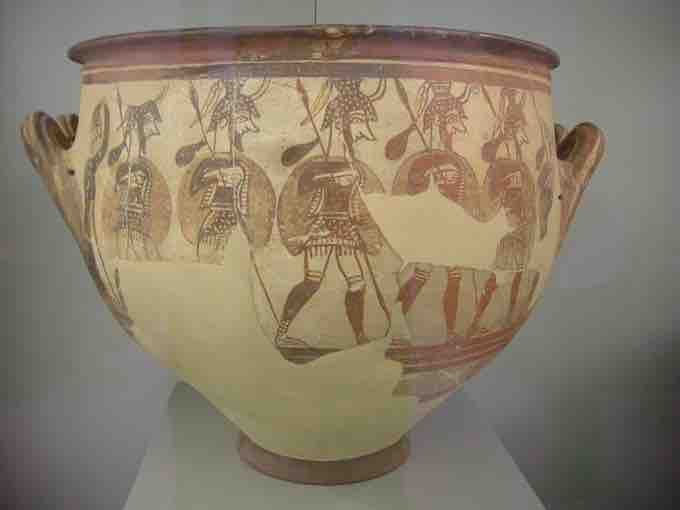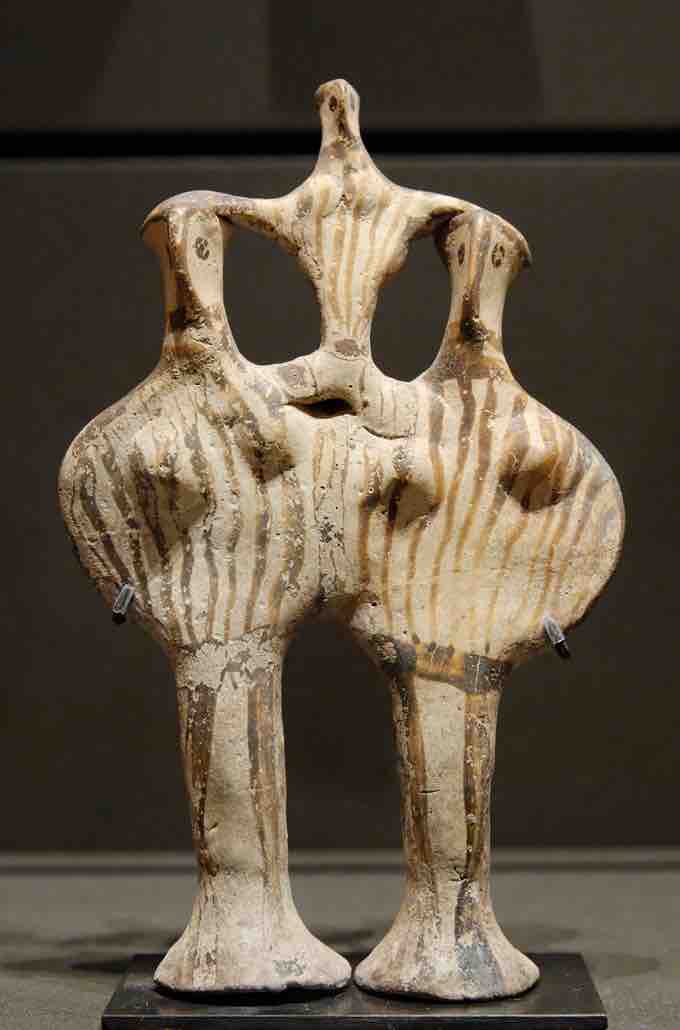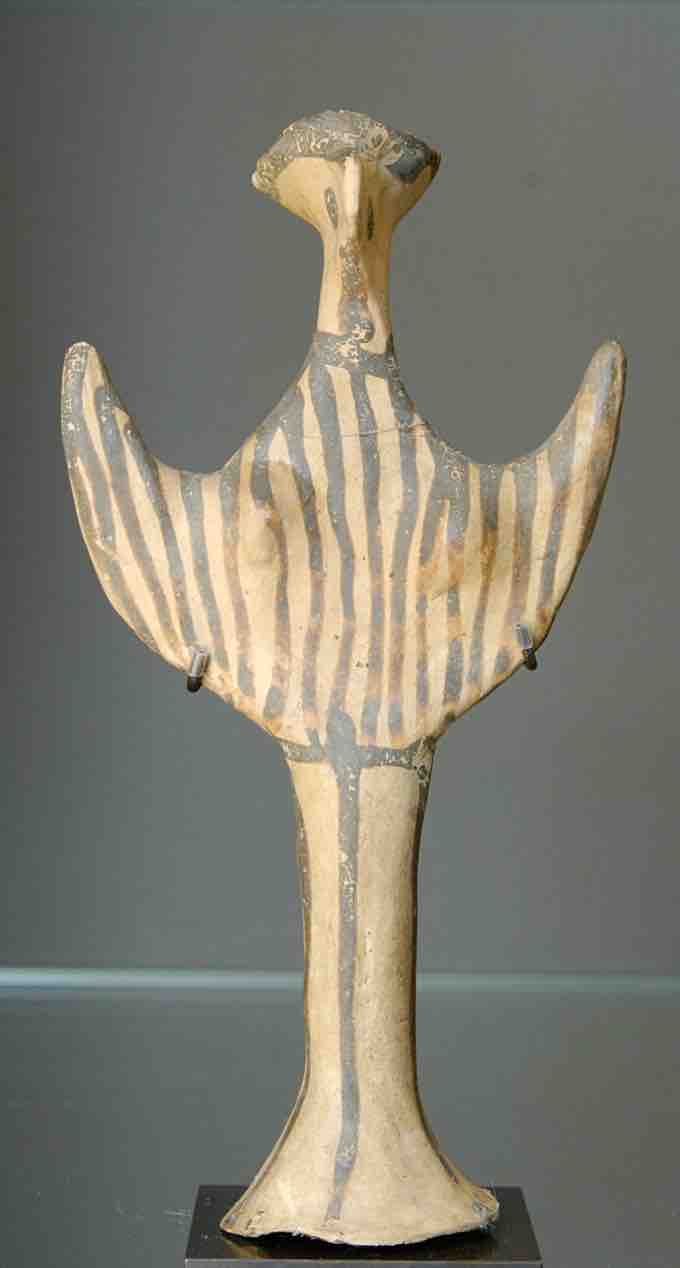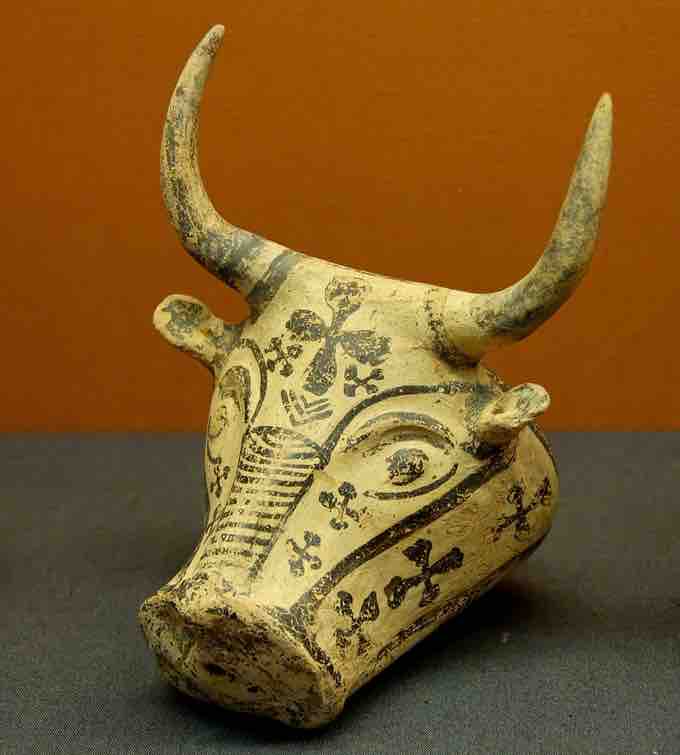The Mycenaeans created numerous ceramic vessels of various types and decorated in a variety of styles. The vessels were popular outside of Greece, and the decorated and stylized vessels were often exported and traded around the Mediterranean and have been found in Egypt, Italy, Asia Minor, and Spain. Two of the main production centers were the Mycenaean cities at Athens and Corinth. The products of the two centers were distinguishable by their color and decoration. Corinthian clay was a pale yellow and tended to feature painted scenes based on nature, while the Athenian potters decorated their vessels with a rich red and preferred geometric designs.
Vessels
The most popular types of vessels included kraters, large open mouth jars to mix wine and water, pitches, and stirrup jars, which are so named for the handles that came above the top of the vessel. Mycenaean vessels usually had a pale, off-white background and were painted in a single color, either red, brown, or black. Popular motifs include abstract geometric design, animals, marine life, or narrative scenes. The presences of nature scenes, especially of marine life and of bulls, seems to suggest a Minoan influence on the style and motifs painted on the Mycenaean pots.
Vessels served the purposes of storage, processing, and transfer. There are a few different classes of pottery, generally separated into two main sections: utilitarian and elite. Utilitarian pottery is sometimes decorated, made for functional domestic use, and constitutes the bulk of the pottery made. Elite pottery is finely made and elaborately decorated with great regard for detail. This form of pottery is generally made for holding precious liquids and for decoration.
Stirrup Jars
Stirrup Jars, mainly used for storing liquids such as oil and wine, could have been economically valuable in Mycenaean households. The arrangement of common features suggests that a stopper is used to secure the contents and the contents are what make the jar a valuable household item. The disc holes and third handle may have been used to secure a tag to the vessel suggesting a commercial importance and resale value. The locations where stirrup jars have been found in reflect the fact that the popularity of this vessel type spread quickly throughout the Aegean and the use of the stirrup jar to identify a specific commodity became important.
Mycenaean stirrup jar
Terra cotta. c. 1350 BCE.
Warrior Vase
The Warrior Vase (c. 12oo BCE) is a bell krater the depicts a woman bidding farewell to a group of warriors. The scene is simple and lacks a background. The men all carry round shields and spears and wear helmets. Attached to their spears are knapsacks, which suggest that they must travel long distances to battle. On one side, the soldiers wear helmets ornamented with horns. The soldiers on the other side wear "hedgehog" style helmets. A single woman stands to the left with her arm raised and a group of identically dressed and heavily armed men marching off to the right. There is no way to tell which woman is waving goodbye, as all the figures are generic and none specifically interacts with her, nor do they interact with each other. The figures are stocky and lack the sinuous lines of the painted Minoan figures. Furthermore, while the men all face right with wide stances and appear to move in that direction, their flat feet and twisted perspective bodies inhibit any potential for movement. Instead the figures remain static and upright. The imagery depicts a simple narrative that in the warrior culture of the Mycenaeans must have often been reenacted.

Warrior Vase
Warrior Vase. Terra cotta. c. 1200 BCE. Mycenae, Greece.
Many scholars observe that the style of the figures and the handles of this thirteenth century BCE vase are very similar to eighth century BCE pottery. Similar spearmen are also depicted in eighth century BCE pottery which introduces a curious 500 year gap in styles.
Figurines
Small terra cotta figurines and statuettes are found throughout Mycenaean grave sites and cities. The purpose of these figures is unknown, although they may carry a votive or cult association. Some figurines found in children's tombs may be toys. The most common style depicts female figures and are from the fourteenth- and thirteenth centuries BCE. The figures are small and are divided into two categories: those that look like the Greek letter phi ("phi-types"), with a rounded upper body shape, and those that look like the Greek letter psi ("psi-types"), which have outstretched arms. Both figures have heads that are narrow and pinched into a triangle. Details such as the eyes, mouth, and nose are painted on. The bases of the figures is cylindrical and their legs seem to have been painted on as a visual afterthought. These figures are painted simply with stripes and zigzags, often on the upper body, and details such as eyes are also added in with paint, while breasts are portrayed with clay protrusions.

Phi Figures
Mycenaean Phi Figures. Terra cotta. c. 13th c. BCE. Mycenae, Greece.

Psi Figure
Mycenaean Psi figure. Terracotta. Ca. 1280 BCE. Tiryns, Greece.
There are few examples of large scale freestanding sculptures from the Mycenaeans. A painted plaster head of a female -- perhaps depicting a priestess, goddess, or sphinx -- is one of the few examples of large scale sculptural work. The head is painted white, suggesting that it depicts a female. A red band wraps around her head with bits of hair underneath. The eyes and eyebrows are outlined in blue, the lips are red, and red circles surrounded by small red dots are on her checks and chin.

Female head.
Female head of a priestess, goddess, or sphinx. Painted plaster. c. 1300-1250 BCE. Mycenae, Greece.
Rhytons
Rhytons are elaborate and decorative drinking cups that often take the shape of animals. They can be made of precious materials, such as gold or silver, but may also made of terra cotta. Several Mycenaean rhytons have been excavated, and include one in the shape of a boar's head and another in the shape of a bull's head. The bull-headed rhyton may have been influenced by or intended for trade with the Minoans. Both of these rhytons are conically shaped and are painted in a single color with abstract shapes and defining features, such as ears and eyes.

Bull Headed Rhyton
Bull headed rhyton. Terra cotta. c.. 1300-1200 BCE. Mycenae, Greece.